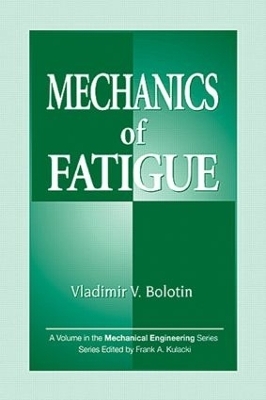
Mechanics of Fatigue
Seiten
1999
Crc Press Inc (Verlag)
978-0-8493-9663-2 (ISBN)
Crc Press Inc (Verlag)
978-0-8493-9663-2 (ISBN)
Addresses the range of topics concerning damage, fatigue, and fracture of engineering materials and structures. This book is suitable for students dealing with mechanical aspects of fatigue, conducting research in fracture mechanics, structural safety, mechanics of composites, as well as modern branches of mechanics of solids and structures.
Mechanics of Fatigue addresses the range of topics concerning damage, fatigue, and fracture of engineering materials and structures. The core of this resource builds upon the synthesis of micro- and macro-mechanics of fracture. In micromechanics, both the modeling of mechanical phenomena on the level of material structure and the continuous approach are based on the use of certain internal field parameters characterizing the dispersed micro-damage. This is referred to as continuum damage mechanics.
The author develops his own theory for macromechanics, called analytical fracture mechanics. This term means the system cracked body - loading or loading device - is considered as a mechanical system and the tools of analytical (rational) mechanics are applied thoroughly to describe crack propagation until the final failure.
Chapter discuss:
preliminary information on fatigue and engineering methods for design of machines and structures against failures caused by fatigue
fatigue crack nucleation, including microstructural and continuous models
theory of fatigue crack propagation
fatigue crack growth in linear elastic materials subject to dispersed damage
fatigue cracks in elasto-plastic material, including crack growth retardation due to overloading as well as quasistationary approximation
fatigue and related phenomena in hereditary solids
application of the theory fatigue crack growth considering environmental factors
unidirectional fiber composites with ductile matrix and brittle, initially continuous fibers
laminate composites
Mechanics of Fatigue serves students dealing with mechanical aspects of fatigue, conducting research in fracture mechanics, structural safety, mechanics of composites, as well as modern branches of mechanics of solids and structures.
Mechanics of Fatigue addresses the range of topics concerning damage, fatigue, and fracture of engineering materials and structures. The core of this resource builds upon the synthesis of micro- and macro-mechanics of fracture. In micromechanics, both the modeling of mechanical phenomena on the level of material structure and the continuous approach are based on the use of certain internal field parameters characterizing the dispersed micro-damage. This is referred to as continuum damage mechanics.
The author develops his own theory for macromechanics, called analytical fracture mechanics. This term means the system cracked body - loading or loading device - is considered as a mechanical system and the tools of analytical (rational) mechanics are applied thoroughly to describe crack propagation until the final failure.
Chapter discuss:
preliminary information on fatigue and engineering methods for design of machines and structures against failures caused by fatigue
fatigue crack nucleation, including microstructural and continuous models
theory of fatigue crack propagation
fatigue crack growth in linear elastic materials subject to dispersed damage
fatigue cracks in elasto-plastic material, including crack growth retardation due to overloading as well as quasistationary approximation
fatigue and related phenomena in hereditary solids
application of the theory fatigue crack growth considering environmental factors
unidirectional fiber composites with ductile matrix and brittle, initially continuous fibers
laminate composites
Mechanics of Fatigue serves students dealing with mechanical aspects of fatigue, conducting research in fracture mechanics, structural safety, mechanics of composites, as well as modern branches of mechanics of solids and structures.
Bolotin/, Vladimir V.
Introduction. Fatigue Crack Nucleation and Early Growth. Mechanics of Fatigue Crack Growth. Fatigue Crack Growth in Linear Elastic Bodies. Fatigue Crack Growth in Linear Elastic Bodies (continued). Fatigue Cracks in Elasto-Plastic Bodies. Crack Growth in Hereditary Media. Environmentally Affected Fatigue and Related Phenomena. Fracture and Fatigue of Fiber Composites. Fracture and Fatigue of Laminate Composite Structures.
| Erscheint lt. Verlag | 24.6.1999 |
|---|---|
| Reihe/Serie | Mechanical and Aerospace Engineering Series |
| Verlagsort | Bosa Roca |
| Sprache | englisch |
| Maße | 178 x 254 mm |
| Gewicht | 1050 g |
| Einbandart | gebunden |
| Themenwelt | Technik ► Maschinenbau |
| ISBN-10 | 0-8493-9663-8 / 0849396638 |
| ISBN-13 | 978-0-8493-9663-2 / 9780849396632 |
| Zustand | Neuware |
| Haben Sie eine Frage zum Produkt? |
Mehr entdecken
aus dem Bereich
aus dem Bereich
Buch | Softcover (2023)
Springer Vieweg (Verlag)
CHF 34,95
Normung, Berechnung, Gestaltung
Buch | Softcover (2023)
Springer Vieweg (Verlag)
CHF 55,95
Buch | Softcover (2023)
Springer Vieweg (Verlag)
CHF 34,95


